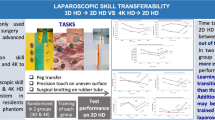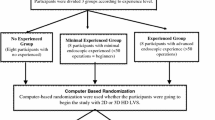Abstract
Background
Two-dimensional high-definition (2D HD) endovision system is preferred for laparoscopic surgery. Recently, new generation three-dimensional (3D) HD and ultra-HD (4K) endovision systems are introduced to improve the safety and efficacy of laparoscopic surgery. There is limited evidence on superiority of one technology over the others. This experimental trial was designed to evaluate 2D HD, 3D HD and 4K HD endovision systems in performance of standardized tasks.
Methods
This was a randomized, cross-over experimental study. Twenty-one surgical residents who were exposed to laparoscopic surgery were enrolled. Participants were randomly assigned into three groups. Each group performed standardised tasks i.e. peg transfer, precision cutting, navigating in space and intra-corporeal suturing using 2D HD, 4K HD and 3D HD endovision systems on a box trainer. Procedures were recorded as 2D HD videos and analysed later. Participant’s perceived workload was assessed using Surg-TLX questionnaire. Primary endpoints were execution time in seconds and error score. Secondary endpoint was workload assessment.
Results
The 3D HD had shorter execution time compared to 2D HD and 4K HD in all tasks except precision cutting (p = 0.004, 0.03, 0.001, 0.001 and p = 0.002, 0.191, 0.006, 0.005 in peg transfer, precision cutting, navigating in space and intra-corporeal suturing respectively). The 4K HD was significantly faster than 2D HD only in navigating in space task (p = 0.002). The error score between 3D HD and 4K HD were comparable in all tasks. The 2D HD had significantly more error scores compared to 4K HD, 3D HD in peg transfer task (p = 0.005, 0.014, respectively). 3D HD had significantly less workload than 2D HD and 4K HD in most of the dimensions of Surg-TLX
Conclusions
3D HD endovision system in comparison to 2D HD and 4K HD, may lead to faster execution without compromising safety of a task and is associated with less workload.


Similar content being viewed by others
References
Pierre SA, Ferrandino MN, Simmons WN, Fernandez C, Zhong P, Albala DM, Preminger GM (2009) High definition laparoscopy: objective assessment of performance characteristics and comparison with standard laparoscopy. J Endourol 23:523–528
Ukai K, Howarth PA (2008) Visual fatigue caused by viewing stereoscopic motion images: Background, theories, and observations. Displays 29:106–116
Storz P, Buess GF, Kunert W, Kirschniak A (2012) 3D HD versus 2D HD: surgical task efficiency in standardised phantom tasks. Surg Endosc 26:1454–1460
Wagner M, Mayer BFB, Bodenstedt S, Stemmer K, Fereydooni A, Speidel S, Dillmann R, Nickel F, Fischer L, Kenngott HG (2018) Computer-assisted 3D bowel length measurement for quantitative laparoscopy. Surg Endosc 32:4052–4061
Sakata S, Grove PM, Hill A, Watson MO, Stevenson ARL (2017) Impact of simulated three-dimensional perception on precision of depth judgements, technical performance and perceived workload in laparoscopy. Br J Surg 104:1097–1106
Usta TA, Ozkaynak A (2015) Kovalak E (2015) An assessment of the new generation three-dimensional high definition laparoscopic vision system on surgical skills: a randomized prospective study. Surg Endosc 28:2305–2313
Mashiach R, Mezhybovsky V (2014) Three-dimensional imaging improves surgical skill performance in a laparoscopic test model for both experienced and novice laparoscopic surgeons. Surg Endosc 28:3489–3493
Tanagho YS, Andriole GL, Paradis AG, Madison KM, Sandhu GS, Varela JE, Benway BM (2012) 2D versus 3D visualization: impact on laparoscopic proficiency using the fundamentals of laparoscopic surgery skill set. J Laparoendosc Adv Surg Technol 22:865–870
Guanà R, Ferrero L, Garofalo S, Cerrina A, Cussa D, Arezzo A, Schleef J (2017) Skills comparison in pediatric residents using a 2-dimensional versus a 3-dimensional high-definition camera in a pediatric laparoscopic simulator. J Surg Educ 74:644–649
Schoenthaler M, Schnell D, Wilhelm K, Schlager D, Adams F, Hein S, Wetterauer U, Miernik A (2016) Stereoscopic (3D ) versus monoscopic (2D ) laparoscopy: comparative study of performance using advanced HD optical systems in a surgical simulator model. World J Urol 34:471–477
Padin EM, Santos RS, Fernández SG, Jimenez AB, Fernández SE, Dacosta EC, Duran AR, Rial MA, Sanchez ID (2017) Impact of three-dimensional laparoscopy in a bariatric surgery program : influence in the learning curve. Obes Surg 27:2552–2556
Kozlov Y, Kovalkov K, Nowogilov V (2016) 3D laparoscopy in neonates and infants. J Laparoendosc Adv Surg Tech 26:1021–1027
Hoffman DM, Girshick AR, Banks MS (2015) Vergence—accommodation con fl icts hinder visual performance and cause visual fatigue. J Vis 8:1–30
Vilaça J, Pinto JP, Fernandes S, Costa P, Pinto JC, Leão P (2017) Comparative study of 2D and 3D optical imaging systems: laparoendoscopic single-site surgery in an ex vivo model. Surg Innov 24:598–604
Arezzo A, Vettoretto N, Francis NK, Bonino MA, Curtis NJ, Amparore D, Arolfo S, Barberio M, Boni L, Brodie R, Bouvy N, Cassinotti E, Carus T, Checcucci E, Custers P, Diana M, Jansen M, Jaspers J, Marom G, Momose K, Müller-Stich BP, Nakajima K, Nickel F, Perretta S, Porpiglia F, Sánchez-Margallo F, Sánchez-Margallo JA, Schijven M, Silecchia G, Passera R, Mintz Y (2019) The use of 3D laparoscopic imaging systems in surgery: EAES consensus development conference 2018. Surg Endosc 33:3251–3274
Abdelrahman M, Belramman A, Salem R, Patel B (2018) Acquiring basic and advanced laparoscopic skills in novices using two-dimensional (2D), three-dimensional (3D) and ultra-high definition (4K) vision systems: a randomized control study. Int J Surg 53:333–338
Harada H, Kanaji S, Hasegawa H, Yamamoto M, Matsuda Y, Yamashita K, Matsuda T, Oshikiri T, Sumi Y, Nakamura T, Suzuki S, Kakeji Y (2018) The effect on surgical skills of expert surgeons using 3D/HD and 2D/4K resolution monitors in laparoscopic phantom tasks. Surg Endosc 32:4228–4234
Kanaji S, Watanabe R, Mascagni P, Trauzettel F, Urade T, Longo F, Guerriero L, Perretta S, Dallemagne B, Kakeji Y, Marescaux J (2019) Three-dimensional imaging improved the laparoscopic performance of inexperienced operators: a prospective trial. Surg Endosc. https://doi.org/10.1007/s00464-019-07308-6
Dunstan M, Smith R, Schwab K, Scala A, Gatenby P, Whyte M, Rockall T, Jourdan I (2020) Is 3D faster and safer than 4K laparoscopic cholecystectomy? A randomised-controlled trial. Surg Endosc 34:1729–1735
Wilson MR, Poolton JM, Malhotra N, Ngo K, Bright E, Masters RSW (2011) Development and validation of a surgical workload measure: the surgery task load index (SURG-TLX). World J Surg 35:1961–1969
Ashraf A, Collins D, Whelan M, Sullivan RO, Balfe P (2015) enhances surgical skills acquisition in standardised laparoscopic tasks: a before and after study. Int J Surg 14:12–16
Harada H, Kanaji S, Nishi M, Otake Y, Hasegawa H, Yamamoto M, Matsuda Y, Yamashita K, Matsuda T, Oshikiri T, Sumi Y, Nakamura T, Suzuki S, Sato Y, Kakeji Y (2017) The learning effect of using stereoscopic vision in the early phase of laparoscopic surgical training for novices. Surg Endosc 32:582–588
Ajao MO, Larsen CR, Manoucheri E, Goggins ER, Rask MT, Cox MKB, Mushinski A, Gu X, Cohen SL, Rudnicki M, Einarsson JI (2020) Two-dimensional (2D) versus three-dimensional (3D) laparoscopy for vaginal cuff closure by surgeons-in-training: a randomized controlled trial. Surg Endosc 34:1237–1243
Zundel S, Lehnick D, Heyne-Pietschmann M, Trück M, Szavay P (2019) A suggestion on how to compare 2d and 3d laparoscopy: a qualitative analysis of the literature and randomized pilot study. J Laparoendosc Adv Surg Tech 29:114–120
Mistry M, Roach VA, Wilson TD (2013) Application of stereoscopic visualization on surgical skill acquisition in novices. J Surg Educ 70:563–570
Yu D, Dural C, Morrow MMB, Yang L, Collins JW, Hallbeck S (2017) Intraoperative workload in robotic surgery assessed by wearable motion tracking sensors and questionnaires. Surg Endosc 31(2):877–886
Koppatz HE, Harju JI, Sirén JE, Mentula PJ, Scheinin TM, Sallinen VJ (2019) Three-dimensional versus two-dimensional high-definition laparoscopy in transabdominal preperitoneal inguinal hernia repair: a prospective randomized controlled study. Surg Endosc. https://doi.org/10.1007/s00464-019-07266-z
Anania G, Agresta F, Artioli E et al (2019) Laparoscopic right hemicolectomy: the SICE (Società Italiana di Chirurgia Endoscopica e Nuove Tecnologie) network prospective trial on 1225 cases comparing intra corporeal versus extra corporeal ileo-colic side-to-side anastomosis. Surg Endosc. https://doi.org/10.1007/s00464-019-07255-2
Fergo C, Burcharth J, Pommergaard HC, Rosenberg J (2016) Age is highly associated with stereo blindness among surgeons: a cross-sectional study. Surg Endosc 30:4889–4894
Bansal VK, Raveendran R, Misra MC, Bhattacharjee HK, Krishna A, Kumar S (2014) A prospective randomized controlled blinded study to evaluate the effect of short-term focused training program in laparoscopy on operating room performance of surgery residents (CTRI /2012/11/003113). J Surg Educ 71(1):52–60
Funding
No research funding received for the paper.
Author information
Authors and Affiliations
Corresponding author
Ethics declarations
Disclosures
Hemanga K Bhattacharjee, Shafneed Chaliyadan, Ashwani Mishra, Harshit Agarwal, Suhani Suhani, Mohit Joshi, Rajinder Parshad, have declared that they have no conflicts of interest or financial ties to disclose.
Ethical approval
A formal ethical clearance was taken for this study.
Informed consent
An informed consent was taken at the time of procedure from each participant.
Additional information
Publisher's Note
Springer Nature remains neutral with regard to jurisdictional claims in published maps and institutional affiliations.
Rights and permissions
About this article
Cite this article
Bhattacharjee, H.K., Chaliyadan, S., Mishra, A.K. et al. Comparison of two-dimensional high-definition, ultra high-definition and three-dimensional endovision systems: an ex-vivo randomised study. Surg Endosc 35, 5328–5337 (2021). https://doi.org/10.1007/s00464-020-07980-z
Received:
Accepted:
Published:
Issue Date:
DOI: https://doi.org/10.1007/s00464-020-07980-z




